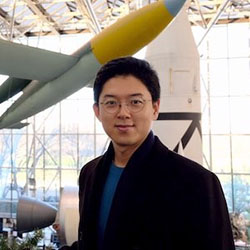Constraining the End of Reionization with Lyman-alpha Spectroscopy
Intae Jung
CRESST II Postdoc
Astrophysics Science Division, Code 665
NASA Goddard Space Flight Center
Wed, March 25, 2020 - 4:00 PM
Karl Herzfeld Auditorium of Hannan Hall - Rm 108
 Reionization of the intergalactic medium (IGM) marks the time in the early universe when the first stars and galaxies began to affect the universe around them. As during this last major phase transition high-energy ultraviolet photons from these objects ionized the gas in the IGM, studying reionization can provide key insights into the formation and evolution of galaxies in the early universe. As Lyman-alpha photons are resonantly scattered by neutral hydrogen in the IGM, an analysis of this line can be used to trace the existence of neutral hydrogen in the IGM at different points in the history of the universe (i.e., when the IGM becomes neutral, we should stop seeing these photons, as they are likely scattered out of our line-of-sight). Spectroscopic data of galaxies in the early universe, obtained with the DEIMOS (optical) and MOSFIRE (near-infrared; NIR) spectrographs on the Keck telescopes, is utilized for investigating the evolution of the IGM during reionization by measuring the Lyman-alpha equivalent width (EW) distribution. I will present the results of the spectroscopic analysis and discuss what can be done with current telescopes and JWST in future on investigating time and spatial evolution of reionization.
Reionization of the intergalactic medium (IGM) marks the time in the early universe when the first stars and galaxies began to affect the universe around them. As during this last major phase transition high-energy ultraviolet photons from these objects ionized the gas in the IGM, studying reionization can provide key insights into the formation and evolution of galaxies in the early universe. As Lyman-alpha photons are resonantly scattered by neutral hydrogen in the IGM, an analysis of this line can be used to trace the existence of neutral hydrogen in the IGM at different points in the history of the universe (i.e., when the IGM becomes neutral, we should stop seeing these photons, as they are likely scattered out of our line-of-sight). Spectroscopic data of galaxies in the early universe, obtained with the DEIMOS (optical) and MOSFIRE (near-infrared; NIR) spectrographs on the Keck telescopes, is utilized for investigating the evolution of the IGM during reionization by measuring the Lyman-alpha equivalent width (EW) distribution. I will present the results of the spectroscopic analysis and discuss what can be done with current telescopes and JWST in future on investigating time and spatial evolution of reionization.
Refreshments served at 3:45 PM
If you have any questions about the Colloquium Series or would like to make a donation please contact the Department of Physics, cua-physics@cua.edu or (202) 319-5315.
